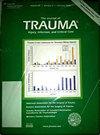Traumatic brain injury and posttraumatic stress disorder: overlap in underlying substrates.
Journal of Trauma-Injury Infection and Critical Care
Pub Date : 2011-12-01
DOI:10.1097/TA.0b013e31823a52cc
引用次数: 0
Abstract
To the Editor: We read with interest the article titled “Routine Follow-Up Imaging of Kidney Injuries May Not Be Justified” written by Bukur et al. and wish to comment respectfully on the use of nephrectomy verses renorrhaphy in this interesting report. In this series, there seems to be a 100% nephrectomy rate in patients with blunt trauma who underwent operative management. This included 5 out of 5 patients with highgrade injury and the only patient with low-grade blunt trauma who underwent surgery.1 This is interesting in the light of an overall greater tendency toward renal repair rather than removal in academic centers.2 In their series of 94 patients with grade III-IV blunt renal injury, Shirazi et al. had a 41% rate of operative management, 31 cases (75%) of which underwent nephrorrhaphy. This higher rate of renal repair can however partly be explained by lower overall grade of injury in this series.3 In addition, no comment was made about whether gunshot wounds were also included in the series. In our opinion, the 21% nephrectomy rate in grade I-III renal injuries was suggestive of possible presence of gunshot wounds. As a conclusion, although the overall trend is obviously toward less invasive measures,4 the mentioned comparison seems to support institutional tendencies toward various management protocols in this ever-evolving topic, a fact pointing to a need for further standardization.创伤性脑损伤与创伤后应激障碍:基础上的重叠。
本文章由计算机程序翻译,如有差异,请以英文原文为准。
求助全文
约1分钟内获得全文
求助全文
来源期刊

Journal of Trauma-Injury Infection and Critical Care
CRITICAL CARE MEDICINE-EMERGENCY MEDICINE
自引率
0.00%
发文量
0
审稿时长
3 months
 求助内容:
求助内容: 应助结果提醒方式:
应助结果提醒方式:


